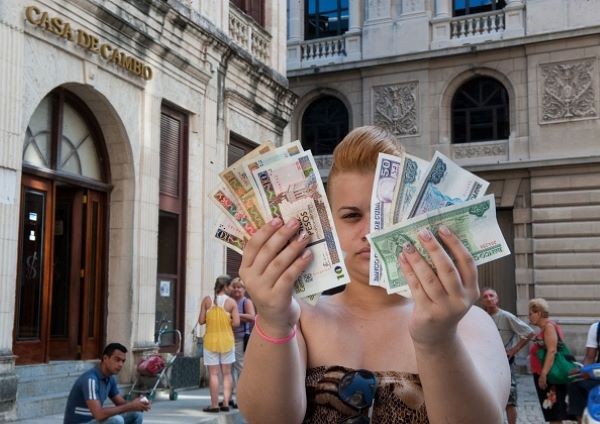Monetary Bang and Inflation after the January 2021 Devaluation of the Cuban Peso
On January 1, 2021, the two Cuban currencies will merge and the Cuban peso will be devalued against the dollar. While necessary for the economy to prosper, these actions will significantly reduce the purchasing power of Cubans.
Luis R. Luis, International Economist, Specializing in International Finance and Investments
The Cuban government set January 1, 2021 as day zero when the convertible peso (CUC) will merge into the Cuban peso (CUP) which will devalue from one per dollar to a new rate of 24 per dollar. These two policy actions, currency unification combined with the devaluation of the peso have long been announced. They are seen by economists as necessary to help restore competitiveness to the economy. As with difficult medical treatments, these measures will come with important side effects in terms of a possible loss of purchasing power by the population in the medium-term.
The weighted-average devaluation on January 1st combining CUP and CUC adjustments will be a factor of around 6 times. This is based on my estimate of an average accounting rate of four per dollar on combined CUP and CUC transactions in 2019.[1] The pass-through effect of the devaluation on consumer prices will be high because of food and energy imports priced in foreign currency are 46% of total imports in 2018 and comprise a large part of household consumption.[2] Anticipating forthcoming cost pressures the government has released a list of price and salary adjustments to be in effect on devaluation day.[3] So, for example, the minimum wage will be raised by a factor of 5¼ and electricity tariffs and many other services by a factor of 5. Officials indicate that the net result of these price and tariff adjustments will be lower subsidies to consumers and state firms.
The money supply in Cuba prior to the devaluation and unification is M = Ma + kMb, where Ma is the CUP money supply and Mb the CUC times the exchange rate between both national currencies. The government has given 180 days or up to the end of June to exchange CUPs for CUCs at the internal exchange rate of k=24. Some currency substitution has taken place before January 1, 2021, as people fled the CUC, but there will be a part that will not be exchanged, probably small. However, general salary and cost increases and financing of food and other subsidies will require swift expansion of M to cover government borrowing requirements. Even as the government projects subsidies will slow, sizable monetary expansion will go on after the initial monetary bang on January 2021. Shortages of many goods and services will also pressure prices. The dollar premium in the black-market will persist, supported by the current misguided policy of offering many products exclusively in high-markup state dollar stores.
The black market for dollars is alive in Cuba. Dollar quotes range between 30 pesos to 45 pesos per dollar implying the new official exchange rate of 24 pesos per dollar is below a rate that will clear the market. The bid-offer spread in the dollar/peso market as may be expected is high, often over 20%, because the market is illiquid and risky for market makers. Indeed, it is preferable to promote rather than discourage this parallel market and thus improve liquidity, easing the black-market premium on the dollar.
Cuba does not have reliable price indices. The just published Anuario Estadistico 2019 of the ONEI statistical institute does not contain an index of consumer prices![4] In the past, ONEI price indices have not taken accurate account of the roughly one-third of the economy that functions in CUC/dollars at market-determined prices.
Private activities operating largely in CUCs will be much less impacted by the devaluation than state activities operating in pesos, as the CUC is not being devalued. Over time, fiscal and monetary expansion and exchange rate expectations will set price dynamics. There will be huge pressure to maintain subsidies to state firms to reduce lay-offs with a consequent high public sector deficit. Efforts to limit the deficit and central bank financing will be challenging. The 2021 state budget shows a projected deficit of 86.8 billion pesos.[5] While projected nominal GDP figures are not available, such a deficit will likely exceed 10% of GDP in 2021.
The dollar crunch facing the country at the same time will mean continuing shortages of basic foodstuffs, fuel and medicines, as well as many consumer goods. These may be available in the black market at high peso prices. Importantly, the economy’s dollar shortage amidst the devastating impact of the pandemic on tourism, the collapse of services exports to Venezuela and anemic foreign investment imply unstable expectations about the future exchange rate of the peso.[6] The possible lifting of some sanctions on tourism by U.S. citizens will provide limited help as pandemic fear recedes in the second half of 2021.
The elements mentioned above, fiscal and monetary expansion combined with shortages and dollar scarcity, provide unfavorable inflation dynamics in the medium-term. Whether or not this is properly registered in official consumer price indices, if they become available, the effective prices paid for many essential items by citizens will surpass nominal wage and salary increases by a significant amount.
[1] The methodology used in this calculation is described in Luis, L. R. (2018), “Cuban Peso Unification: Managed Rate and Monetary Analysis.” Cuba in Transition, Volume 28, 2018.
[2] Oficina Nacional de Estadistica e Informacion, Anuario Estadistico 2019, Sector Externo, 2019.
[3] Gaceta Oficial, Numeros 68-73, Extraordinaria de 10 de diciembre de 2020.
[4] Ibid.
[5] “Conozca el presupuesto del Estado en el primer año del ordenamiento monetario,” Cuba Debate, 17 diciembre 2020.
[6] Luis L. R. “Dollar Crunch, Dollarization and Devaluation”, Horizonte Cubano, October 2020.

Luis R. Luis is an international economist in Massachusetts specializing in international finance and investments. He is cofounder of International Research and Strategy, a firm centered on emerging markets finance. Previously he was Managing Director at Scudder Investments in Boston directing international research and helping to manage international fixed income and equity portfolios. He was Director, Latin America Department, at the Institute of International Finance in Washington. Luis also served as head of international economics at Midland Bank in London and Crocker Bank in San Francisco and was Chief Economist at the OAS in Washington. He was in the economics faculty at the US Naval Academy in Annapolis and American University and held a Fulbright visiting professorship at University of Trujillo in Peru. He has lectured on international economics at universities in several South American and European countries. An author of articles on international finance and on the Cuban economy and a contributor to several books on emerging markets and portfolio management, Luis holds a PhD degree in economics from the University of Notre Dame.

